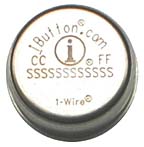Key Clock in a Button

Many system makers have standardized on barcodes and chips, with chips catching on with users often seeking out a system with a diversity of applications.
Made by Maxim/Dallas Semiconductor of Dallas, Texas, the iButton is a computer chip with a unique 64bit address encased in a 16mm stainless steel “can.” The stainless steel “can” does double duty: to protect the chip inside and for its electronic communications interface. Each “can” has a data contact which is called the “lid” and a ground contact which is called the “base.” By simply touching each of the two contacts you can communicate to any iButton and read its address in less than 5 milliseconds. The basic 64bit iButton is in most guard tour systems.
Reader Durability
In the guard tour business, the most costly part of any system is the reader. Therefore, the most durable reader will reduce system cost over time. One iButton reader on the market is so durable that it actually comes with an internal shock sensor. Not only does it keep on working after abuse, it tells a security director or supervisor when an officer is trying to break the device.Regardless of the tag technology in use, systems are available from a variety of vendors that support the following communication options for uploading guard tour data from the reader to personal computers and networks.
- RS-232 and USB to PC
- IR to PDA devices
- One-Wire to PDA devices (iButton only)
- Modem to Server or ISP
- TCP/IP to Local or Remote Network
- GSM and Cell Phone to Network
Looking for a reprint of this article?
From high-res PDFs to custom plaques, order your copy today!







